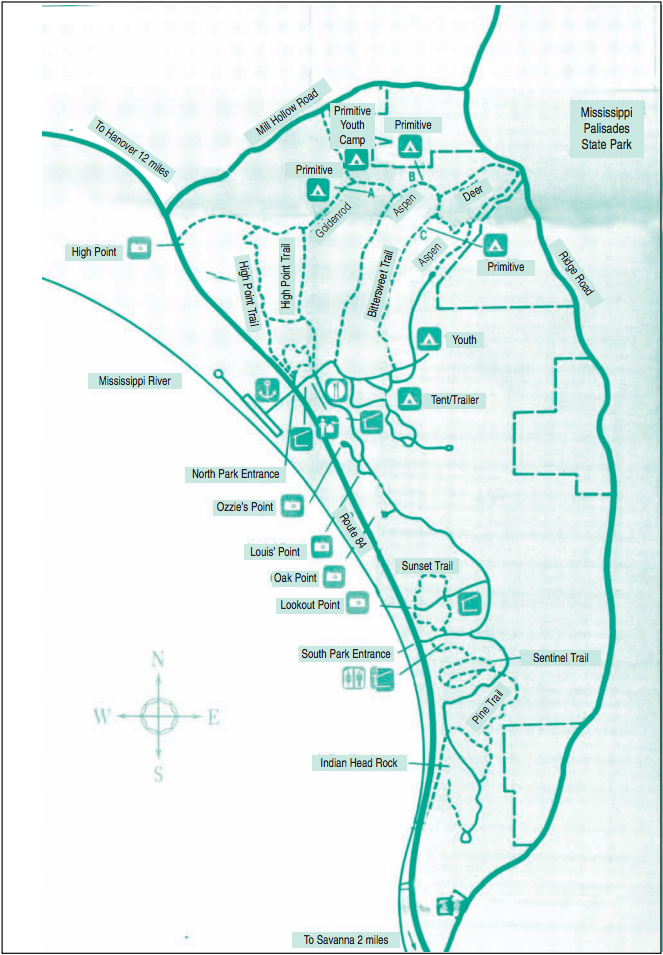Mississippi Palisades is well known for its concentration of breeding forest birds, especially warblers. At other seasons, almost anywhere in or around the park can be great birding, this entry is concerned with the breeding species that can be found primarily May–August.
South Entrance
At the first parking lot (by the large shelter) there is a creek that runs along the right side of the road when driving in. This area has several pair of Louisiana Waterthrush, and Yellow-throated Warbler can be found in the large Sycamores nearby. Both of these species can be found almost anywhere there is appropriate habitat in the park.
Along the next stretch of road, up until the split (about 1/4 mile), Black-throated Green Warbler and Summer Tanager have been seen.
South Road
Shortly after the split (where one road goes to the south end of the park/Indian Rock, and the other to the north/campground), there is a pull-off for two or three cars. This location, where the creek crosses under the road, is excellent for Louisiana Waterthrush, Acadian Flycatcher, Black-throated Green Warbler, Kentucky Warbler and is perhaps the easiest place in Illinois to see Cerulean Warbler. Other species found at this spot include Pileated Woodpecker, Winter Wren (singing in June), Black-and-white Warbler, Chestnut-sided Warbler, and a host of other, more common, woodland species.
Driving along the road to the south, Hooded Warbler can be heard almost anywhere, but the easiest place to see one is near the parking lot for Pine Trail. Summer Tanager have been recorded here as well.
Continuing south, the road goes down a steep ravine, and comes out to an open area with a shelter and parking lot. The tall Sycamore trees here often have Northern Parula. From here the road goes through excellent deep-woods habitat (Veery, Wood Thrush, Yellow-throated Vireo), and along the next 1/2-mile stretch any of the above-mentioned species may be encountered. The road ends in a loop, the center of which contains a stand of tall pine trees. These trees are the best place in the park to find Yellow-throated Warbler. Kentucky Warbler can also be found here, and Yellow-bellied Sapsucker is a breeding bird here. Sapsuckers are actually common breeding birds in Carroll and Jo Daviess counties, and can be found almost anywhere with diverse woodland habitat.
On the east side of the loop is a trailhead that leads through an open, brushy area. Blue-winged Warbler have been recorded here in summer.
North Road
Going back to where the road splits (near the south entrance) and going right at the fork will take you to the campground, eventually. At the first two-car pull-off (near the top of the very steep drive up the ravine) Broad-winged Hawk has nested—listen for their high-pitched calls. Broad-wings have been seen in several spots along the stretch of road north of here as well.
All of the species listed above can be found along the north road as well. If you haven’t already found one, the pines and wood near where the access road to Lookout Point meets the main road is almost sure-fire for Yellow-bellied Sapsucker. Barred Owl has been found here as well.
In the pines near the campground, Yellow-throated Warbler and Eastern Screech Owl have been recorded.
Mill Hollow Road
Mill Hollow Road is north of the park—actually outside the park—but runs along the north border. Many of the species listed above can be found by slowly trolling along this quiet gravel road. At the Primitive Youth Camp Entrance, Yellow-billed Cuckoo, Whip-poor-will and Barred Owl have been recorded.
Scenic Ridge Road
This road runs along the east side of the park, and has most of the hunters access parking lots. Driving south along this road there are several large, grassy fields that have nesting Henslow’s Sparrow.
